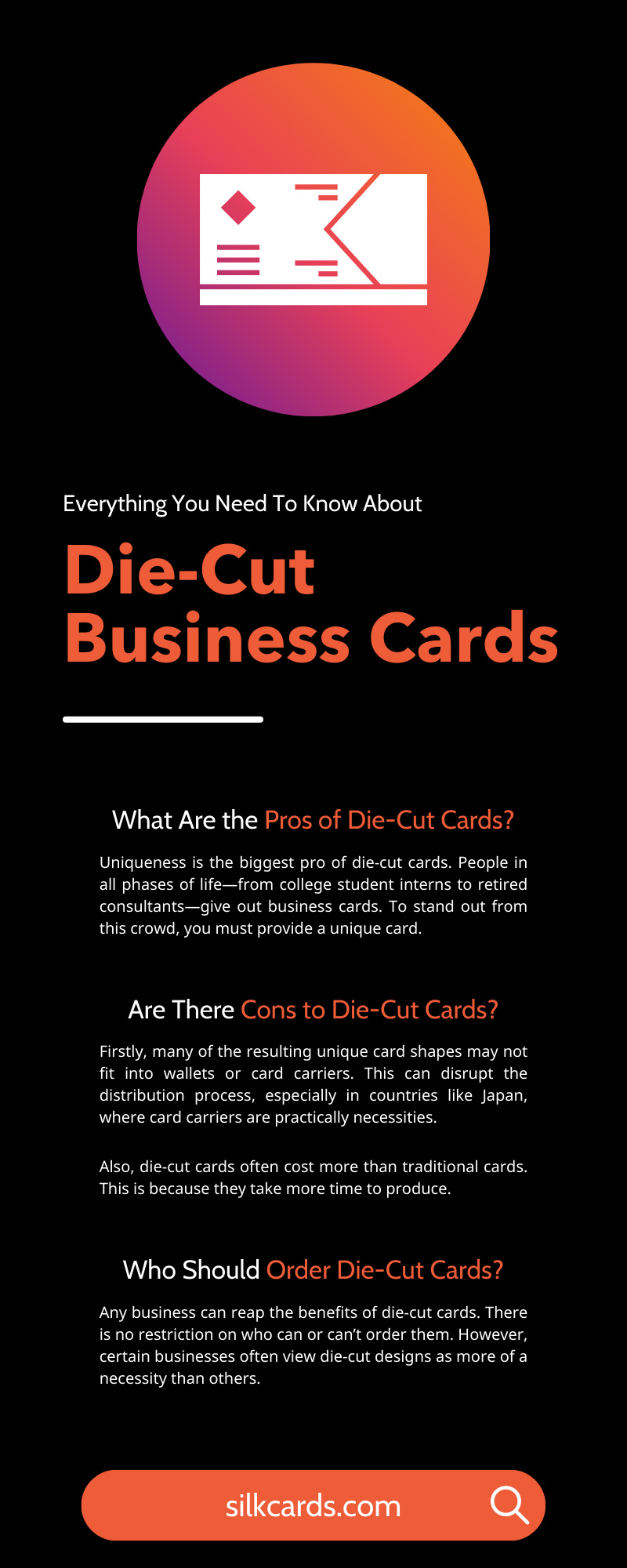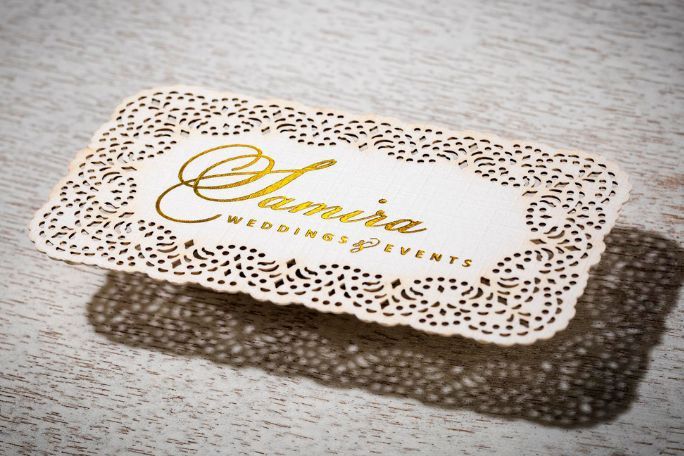What shape do you picture when you think of the phrase “business card”? Most people imagine a rectangle. While this shape is easy to hold and fits nicely in a wallet or card holder, many people find it boring now. When every business card is the same shape and looks the same, it’s difficult to look at a new card with excitement.
Die-cut business cards are a solution to this problem. Keep reading to learn everything you need to know about these cards so you can order them for your business.
What Is Die Cutting?
Many people have heard the phrase “die cutting,” but they don’t know what it means. Die cutting refers to a metal die cutter shearing through weak materials, often paper. Small die cutters are manually operated. A person lays several sheets of paper onto a strong board. They then lower the metal die cutter on top of the paper and apply force, often with a lever. This forces the die cut through the paper. When the person removes the die cutter from on top of the paper, the paper is left in whatever shape the die cutter was in. Die cutters can come in any shape, even custom ones, to allow for unique designs.
Laser cutters can mimic this process. They simply use a laser, which is often machine operated, to create the design instead of the die cutter. The result is very similar, and many people cannot tell the difference between these processes.
How Does Die Cutting for Business Cards Work?
Now that you understand the die-cutting process, you can start to visualize how it works for business cards. The operator makes the custom metal die cut and then finds the requested die-cut design or programs the laser to create the desired design. They then place the customer’s desired cardstock onto the board. Once the cardstock is ready, they can lower the metal die cut or start the laser cutter. After the metal die cutter or laser cutter slices through all the cardstock, the operator can remove the cards and reveal the design.
How Do Die-Cut Business Cards Differ From Traditional Ones?
Most printers use a paper cutter for traditional rectangular business cards. While there are different types of paper cutters, most cut in straight lines. This is how they create the perfect rectangle you recognize as a business card. While these cutters can create other shapes from straight lines, such as squares and triangles, these shapes aren’t as unique as die-cut results. Squares and triangles will still stand out from rectangular cards, but die-cut designs are what really capture the eye.
What Die-Cut Design Options Are There?
Some of the most popular die-cut designs are leaves, circles, and ovals. Since traditional paper cutters can only cut in straight lines, die cutters must produce these curved designs. There are many other die-cut design options you can choose from, but consider taking advantage of these unique shapes.
Keep in mind that the available die-cut design options depend on your printing service. Larger printing companies often have more die-cut designs ready and can craft custom die cuts. Smaller companies usually have fewer resources at their disposal, including for their die-cut designs. While this isn’t inherently a bad thing, it does mean you won’t have as many unique options to choose from.
What Are the Pros of Die-Cut Cards?
Uniqueness is the biggest pro of die-cut cards. People in all phases of life—from college student interns to retired consultants—give out business cards. To stand out from this crowd, you must provide a unique card.
There are additional advantages to ordering die-cut business cards that go beyond their uniqueness. Putting so much thought into your card design shows potential partners and customers that you are detail oriented and care about your business. Anyone can claim that they focus on details and care about their work; a die-cut business card proves that you’re telling the truth. This proof also shows that you’re a person of your word, making people want to partner with and purchase from you.
Are There Cons to Die-Cut Cards?
There are a few cons to die-cut cards that you should know before ordering. Firstly, many of the resulting unique card shapes may not fit into wallets or card carriers. This can disrupt the distribution process, especially in countries like Japan, where card carriers are practically necessities. If you are planning to take your card to another country, learn about their business etiquette. Discern whether they will appreciate a die-cut card before ordering.
Also, die-cut cards often cost more than traditional cards. This is because they take more time to produce. While many people believe the cost is worth it, you may want to reconsider die-cut cards if you are on a tight budget.
Finally, if you are ordering a custom die-cut design, then your cards may take more time to arrive than non-custom cards would. The printing service must craft the custom die cut before they can start working on your cards, which adds extra time to the process. If you need business cards quickly but still want the advantages of die-cut cards, consider ordering a design the printer already has. You can always order a custom design in the future when you have more time.
Who Should Order Die-Cut Cards?
After weighing the pros and cons of die-cut cards, you can decide whether you want to order some for your business. Any business can reap the benefits of die-cut cards. There is no restriction on who can or can’t order them. However, certain businesses often view die-cut designs as more of a necessity than others.
For example, graphic design businesses often want to display their design prowess in their business cards. Many of them choose custom die-cut designs for this reason. Also, many small businesses, no matter their industry, often choose die-cut business cards to stand out from large corporations.
There you have it: everything you need to know about die-cut business cards. Information is power, and we are glad to keep you informed so you’re empowered to make the right decision for your business. You can order custom die-cut business cards from us to reap the advantages of these unique cards.


